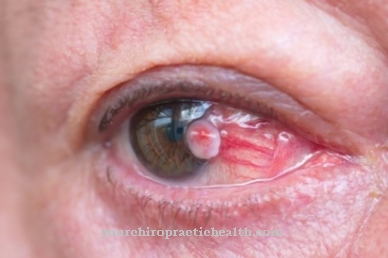Of the splayfoot or Pes transversoplanus is an avoidable spread of the forefoot, which is often caused by obesity and incorrect footwear.
What is splayfoot?

© Aksana - stock.adobe.com
Under a splayfoot one understands a visible and measurable deformation of the entire forefoot. It is caused by the lowering of the front arch in the foot.
As a result of the lowering, the toe bones spread visibly apart. Chronic overloading of the toe joints on the little and big toes and characteristic calluses develop.
As a result of further stress, the splayfoot develops into a painful foot, which is followed by typical misalignments and symptoms of excessive strain on the toes.
causes
Among the causes that lead to the development of splayfoot are overweight, unsuitable footwear without adequate arch support, a weakness for high heels or hereditary connective tissue weaknesses. Certain bone fractures in the forefoot area can also promote splayfoot.
The so-called “march fracture” should be mentioned here in particular. It is a fatigue fracture on the metatarsal bones. It can arise in the event of overload or unfamiliar loads such as long walks. Splayfoot is about four times more likely to be diagnosed in women than men. The reason is that women are more likely to wear unsuitable high-heeled shoes.
As a result, the forefoot is stressed beyond normal. Tight shoes - just like shoes that are cut too wide - cannot prevent splayfoot in the long term if the arch of the foot is not supported. The splayfoot often remains symptom-free in the first few years.
As a result of the forefoot spreading apart, however, changed gait habits and the resulting repeated incorrect loads may arise. The increasing spreading process can lead to misalignments on the toes or joint diseases on the foot. The famous hallux valgus, the so-called hammer toe, osteoarthritis of the toe joints, corns or the Morton's neuroma are attributed to the splayfoot.
Symptoms, ailments & signs
A splayfoot can first be recognized by the characteristic malformation of one or both feet. Typically, the forefoot is broadened and lowered while the big toes slide outward. The pain occurs mainly when walking and standing. At rest there are no complaints, as long as there are no subsequent complaints.
However, the changed position of the foot can lead to the development of claw toes or hammer toes. Over time, splayfoot can lead to pain and calluses on the sole of the foot. Normal walking is usually no longer possible, which can result in avoidance behavior and other misalignments in those affected. A splayfoot can be recognized by the unusual rolling movement of the sole, in which those affected roll the foot over the outer foot.
Accordingly, swelling and callus formation occur mainly on the outside of the foot. If a splayfoot is operated on early, the symptoms can be completely eliminated. If the treatment is too late, permanent damage to the foot may already have occurred. Possible consequential symptoms are joint wear, bone damage, skin changes or walking disorders. Particularly in the case of a congenital splayfoot, a defective gait can develop in the course of childhood, which affects posture.
Complications
Splayfoot can overstretch muscles and ligaments. This can result in chronic incorrect loading of the affected bones and joints. Thick, painful calluses often form under the skin of the sole. A typical complication is the so-called Morton's neuralgia, a permanent irritation of the nerves that leads to nerve knots in the long term.
These knot-like thickenings cause severe pain and are often associated with restricted mobility and sensitivity disorders. A splayfoot also promotes the formation of toe deformities such as hallus valgus, mallet toe or claw toe. Once created, further deformities can lead to far-reaching complications and chronic movement restrictions, which in certain circumstances can also lead to mental illnesses such as depressive moods or inferiority complexes.
There are also risks involved in treatment. Poorly adjusted aids can under certain circumstances intensify the splayfoot and cause further pain. Surgical intervention carries the usual risks: bleeding, secondary bleeding, nerve injuries, scarring and inflammation. Prescribed medication can have side effects and trigger allergies.
The most common side effects are gastrointestinal complaints, edema and blood clotting disorders. Stomach ulcers and kidney disease can rarely occur. An intolerance to the prescribed pain relievers and anti-inflammatory drugs cannot be ruled out.
When should you go to the doctor?
If a splayfoot occurs, a doctor must usually be consulted. If the splayfoot is not treated correctly or in time, it can lead to serious and, above all, irreversible damage to the feet, which can no longer be treated. The underlying condition should also be treated.
A doctor should be consulted if there are significant deformities in the feet. These can be seen with the naked eye and can appear either on one foot or on both feet. Furthermore, malformations of the toes can also indicate splayfoot and should also be treated by a doctor. Most patients also have a raised cornea or very severe swelling on the feet. Walking disorders can also indicate splayfoot. If these symptoms persist and do not go away on their own, a doctor should definitely be consulted.
A splayfoot can be treated by a general practitioner or an orthopedic surgeon. As a rule, the focus is on the treatment of the underlying disease, so that no general prognosis can be given about the further course of the disease.
Treatment & prevention
You can do one operationally splayfoot not treat. But some of the secondary diseases - such as hallux valgus - can be corrected surgically. To treat the main problem, the splayfoot must be supported early on. The disputed question, however, is what type of health shoe, pad or insole is used to do this.
According to orthopedists, some so-called health shoes promote splayfoot due to their excessive width in the forefoot area. Even with a footbed, the forefoot can be driven too far apart in such shoes - for example if you are overweight or in a standing job. In children, walking barefoot can help strengthen the arch of the foot.
Adults with splayfoot are first advised to lose weight, use orthopedic insoles, walk barefoot and do foot gymnastics. If there are already inflammatory processes in the toe area, immobilization of the foot is helpful. Changing the footwear makes sense when using splayfoot.
The formation of calluses can be counteracted with warm footbaths and callus rasps. It makes more sense, however, to put a stop to calluses on the splayfoot with suitable footwear. Flat shoes with enough space for the toes are advisable for splayfoot.
Aftercare
In most cases, the affected person has only a few and only very limited measures available for direct follow-up care. Therefore, the person affected should first and foremost consult a doctor at an early stage and initiate treatment in order to prevent further symptoms or complications. There is also no independent healing, so treatment by a doctor is always necessary.
In general, a healthy lifestyle also has a very positive effect on the further course of this disease. Obesity should also be avoided as far as possible, whereby the person affected should also do sports to counteract the symptoms. In many cases, suitable footwear can also alleviate and limit the symptoms.
Therefore, special shoes should be made and worn. Regular checks and examinations by a doctor are also very important. As a rule, the symptoms can be well limited so that there is no reduced life expectancy for the person affected. However, the feet should be checked very carefully by the doctor in order to identify any symptoms and damage in good time.
You can do that yourself
In everyday life you should pay particular attention to the selection of footwear. This should not be too tight or have high heels. The size of the shoes should match those of the feet. Before purchasing new shoes, you should always try them on. It is also advisable to check the materials used to make the shoes.
Wearing plastic shoes has proven to be inconvenient. Very flat shoes with a thin sole can also lead to disturbances in everyday life and should also be avoided. As soon as the person concerned perceives discomfort while wearing the shoes, he should take them off and switch to other shoes. For optimal locomotion, closed shoes and wearing cotton hosiery are important.
In order to reduce symptoms, it is also important to ensure that obesity is avoided. A healthy and vitamin-rich diet and checking the calories consumed during the day help maintain a normal weight. Sweets and the consumption of sugary products should be checked daily. Getting enough exercise and engaging in physical activity are also important to avoid obesity. As soon as symptoms of fatigue or symptoms appear, recovery phases should be taken. The feet are to be rested and should be spared.




.jpg)






















